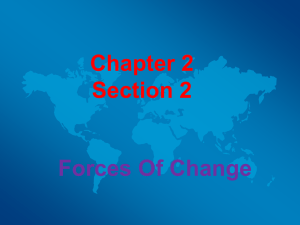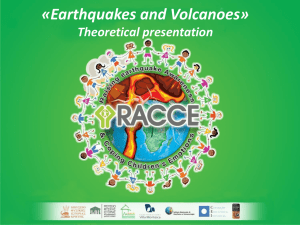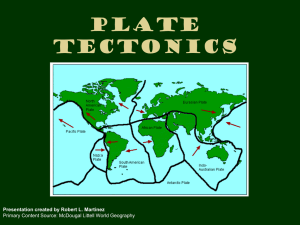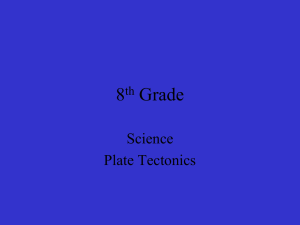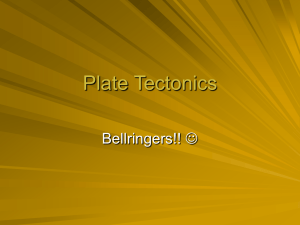Review: Ring of Fire and Earthquakes
advertisement
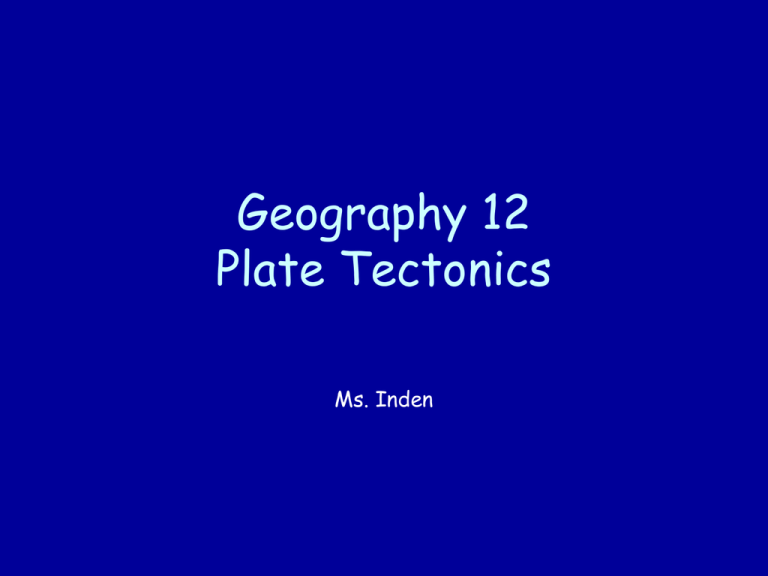
Geography 12 Plate Tectonics Ms. Inden Take a look at this picture of the Ring of Fire! The area that we are discussing is the darker peachy-pink area that surrounds the Pacific Ocean. The Ring of Fire is where a lot of volcanoes and earthquakes occur. WHY HERE?? The Structure of the Earth The earth’s crust • The outer crust of the Earth is a thin layer, like the shell of an egg. • Continental crust is called SIAL • Under it, and also the ocean floor is called SIMA Sima – See many fish Sial – See alpine meadows Plate Tectonics • The crust is broken into pieces, or plates • At the edges of these plates, you will find most of the world’s volcanoes and earthquakes • The reason is that these plates are MOVING! (more on that in a few slides) This is a map of the Earth – Can you see it? You are here! Atlantic Ocean Pacific Ocean Africa Remember that the earth is made up of broken plates of crust? Edges of the plates are in yellow, Earthquakes of the last 100 years are in red The area surrounding the Pacific Ocean is known as the Ring of Fire, because of the volcanoes that occur around its edges – mainly because of the type of plate boundary – subduction – we’ll learn more about that. Ring of Fire Here it is again, without the plates Volcanoes also happen over hotspots – not just where plates come together . These places are called hot spots – like Hawaii and the Galapagos Islands. RED DOTS ARE HOT SPOTS Here are the Earth’s Plates on a map of the world What plates are next to the British Columbia and the rest of North America (i.e., next to California and the San Andreas Fault?) Remember that these plates are moving? How? • Idea: Convection Currents: Cooled material sinks back down, heats and rises again. So, these currents of rising and then sinking molten rock (moving very slowly) acts like conveyor belts that move the plates around – this is the theory of plate tectonics Because the plates move, they create mountains, trenches, volcanoes, earthquakes Here, one plate dives under the other, which creates fold mountains and volcanoes like Mt. St. Helen’s, Mt. Baker, Mt. Bachelor – a row, or arc of volcanoes. Here, plates slide past each other, creating the San Andreas Fault. Here are pictures showing the North American land forms we just looked at: San Andreas Transform Fault Mt. Bachelor Mt. St. Helen’s Mt. Hood These faults, occurring at plate boundaries, or cracks in the earth, come in three different types: • Diverge means to pull apart • Converge – means to come together • Transform faults slide past each other 3 types of faults • Diverge means • Converge means • Transform – When plates pull apart this creates a ridge – because magma wells up • One major diverging plate is the midAtlantic Ridge • Mid means middle, and the Atlantic is the ocean, right? • So, this mountain ridge is in the middle of the Atlantic Mid-Atlantic Ridge –another look Can you see the plates that create the Mid-Atlantic Ridge? Transform Faults – plates or faults sliding past each other • The big one is the San Andreas Fault in California Two types of land forms occur when plates converge: 1. Subduction Zone • Remember that converge means to come together • Called subduction:– where an ocean plate dives under a continental plate • Creates a trench – like along the Andes Mountains, and helps build the mountains • See how it creates volcanoes there – like Mt. St. Helens, Mt. Bachelor, Mt. Baker, Mt. Hood Two types of land forms occur when plates converge: 2. Fold Mountains • Remember that converge means to come together • Sometimes this creates mountains – like the Rockies, and the Himalayas This is how BC was formed and we live on a high plateau ourselves Here is another look at the 3 types Terms for Volcanoes • Molten or melted rock that is below the surface is called magma • Molten or melted rock at the earth’s surface is called lava • Volcanic ash also comes out of the volcano When Mt. St. Helens erupted in 1980, ash and light rock was blown north and west as far as the Manitoba/Ontario border What is an earthquake? • Earthquakes happen when the earth (rock masses) moves suddenly along a crack or fault in the earth’s crust • Faults - cracks or breaks in the earth’s surface • The movements of the earth can be up and down, and side to side • Take a look for the fault – the broken line of earth • An earthquake occurs at the focus, underground • The epicenter of the earthquake is right above it at the surface

